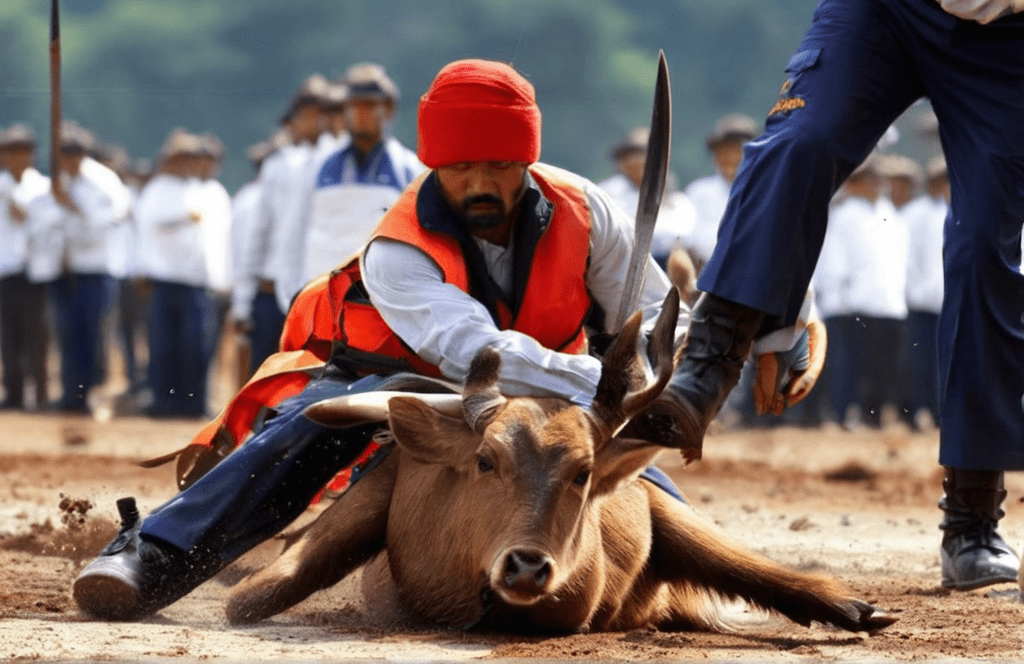Celebrations of festivity and rituals are deeply ingrained in our social and cultural fabric. They allow us to connect, to foster community spirit, and to mark the passage of time in a meaningful way. But all too often, these festive occasions have a hidden cost, unseen but deeply felt — the suffering and death of innocent animals.
In this story, we will delve into the chilly depths of this gruesome practice. We will spotlight the often-overlooked plight of these animals, dissect the reasons for these ritualistic sacrifices, and explore alternative ways to honour traditions and mark life’s milestones.
Remember, this is a thought-provoking analysis. It might make you uncomfortable, guilty, or downright angry. That’s the point. But with understanding comes the chance to effect real change. Could you stick with me? It’s a 1000-word journey but can transform our societal norms and traditions.
Index of Contents
ToggleWhy do people kill animals during festivals?
Religious rites and Beliefs:
Hinduism: Animal sacrifice has been an integral aspect of Hindu rites for ages. It is linked to particular deities and celebrations. During Durga Puja, followers engage in the practice of offering sacrificial animals to the goddess Durga as a means to summon her might and seek her blessings for protection from bad forces.
Interconnected Cultures: Animal sacrifice is frequently associated with religious rituals in diverse cultures, as it is thought to placate or sustain the goodwill of deities. Sacrifices are commonly regarded as acts of reverence and supplication, symbolizing deep devotion and the desire for divine favor.
An Exploration of Symbolism and Tradition:
Analyzing Symbolic Meaning: Certain rituals incorporate the practice of symbolically sacrificing animals. For example, animals can symbolize specific characteristics or adversaries. According to Shakti religion, the use of animal effigies in sacrificial rituals represents the triumph over internal adversaries, such as pride. Custom: Numerous festivals have long-standing customs that involve the ritualistic sacrifice of animals. These customs have been inherited over generations and play a crucial role in cultural festivities.
Historical Background: Traditional Customs: Animal sacrifices were prevalent in ancient India, encompassing both Vedic and non-Vedic practices. The Rigveda and other Vedas provide comprehensive accounts of intricate ceremonies, which encompass the practice of animal sacrifices. The Ashvamedha, an ancient ritual described in Vedic writings, involved the free roaming of a horse for a year before its sacrificial offering.
Local and Tribal Traditions: Certain areas still maintain the practice of animal sacrifices as part of their folk Hinduism and tribal customs. These activities frequently hold historical importance and are firmly rooted in the local culture.
An analysis of Hunting Festivals: On certain occasions, festivals may incorporate hunting competitions where animals are regarded as nuisances or dangers. These events function as a method of population management or safeguarding.
Buffalo Demon Myth: In the context of Durga Puja, the deity Durga emerges victorious over the formidable buffalo demon Mahishasura. The act of sacrificing animals during this event serves as a symbolic representation of her resolute determination to combat malevolent spirits.
To summarize, the rationales behind animal sacrifice during festivals are many, encompassing religious convictions, symbolic significance, cultural legacy, and historical traditions. Nevertheless, there is a wide range of perspectives on this tradition, and ongoing discussions persist regarding its ethical ramifications and importance.
The Unseen Carnage of Festivity

A communal feast is at the heart of most celebrations around the world, whether it be a national holiday, a religious festival, or a society gathering. And at the heart of that feast, more often than not, lies the carcass of a slaughtered animal.
Think about it — the Thanksgiving turkey, the Christmas ham, the sacrificial lamb at Eid, the festival of goats during Dashain, even the Sunday roast honouring no occasion. Behind each delicious course is a life cut short, an animal raised just for that purpose — to end up on our plates.
It’s not an easy image to digest and certainly not festive. But the chilling truth drives a complex network of breeding farms, slaughterhouses, and meat markets. It provides cushy profits for multibillion-dollar industries built on the abuse, degradation, and systematic execution of animals.
Rituals Drenched in Blood
The situation becomes grisly when we consider the ritualistic killing of animals during religious festivals. Tens of millions of creatures, from chickens and goats to water buffalos and camels, are slaughtered worldwide every year as part of religious traditions.
To compound the dreadful reality, these events often involve public displays of animal executions. In some regions, children even take part and watch, becoming desensitized to suffering and death from an early age.
Whether intended or not, these rituals send a powerful message that animal life is less valuable, setting dangerous precedents and shaping cultural perceptions of our relationship with the rest of the animal kingdom.
The Distorted Reflection of Festive Cheer
Our celebrations mirror our times, a reflection of what we value. They reveal how we feel about family, community, joy, spirituality, and animals. But how does a feast that necessitates violence and suffering reflect on us as individuals and a society? How does a celebration that is marred by the unnecessary killing of animals reflect our evolution?
The answer paints an image that is tainted, murky, and unsettling. It masks the true essence of what it means to celebrate – to express joy and gratitude – and instead, it casts a long, unsavoury shadow over these occasions.
A Wake-Up Call to Humane Celebrations
The hallmark of an enlightened society is its ability to honour traditions and its courage to question, modify, or discard those that inflict suffering and harm. And that’s where the potential for a paradigm shift lies.
By acknowledging the cruelty enmeshed in our celebrations, we can foster a collective shift towards more compassionate practices that preserve festive spirit without causing harm to other living beings.
Here are some steps we can consider:
-
- Substituting Animal Proteins: With the rise of plant-based substitutes, exchanging traditional meat dishes for equally delicious, cruelty-free options is easier than ever. These ingenious alternatives cater to different dietary preferences, reducing the demand for animal farming.
-
- Challenging Ritualistic Killings: By sparking debates, harnessing the power of media, petitioning religious leaders, or lawmaking power, we can address and put an end to the practice of ritualistic animal slaughter.
-
- Promoting Animal Rights Education: Incorporating animal ethics and rights into educational curricula can instil the values of compassion, empathy, and respect for animals from a young age.
-
- Legislation and Enforcement: Stricter laws defining animal welfare and rigorous enforcement can ensure fewer animals succumb to inhumane practices during our celebration.
-
- Choosing Compassionate Traditions: Opt for cruelty-free rituals and customs that respect all life forms. For instance, lighting lamps, planting trees, or community service can enrich our celebrations without causing harm to animals.
The Promise of Celebration
Celebrations are not inherently harmful. They hold a special place in our cultures and societies, symbolizing what is important. By consciously reshaping our practices and choosing compassion over tradition, we can uphold the true spirit of festivity.
I intend not to discourage celebration by presenting such a gruesome yet realistic account. Instead, I aim to provoke thought — to make you question the authenticity of joy obtained at the cost of innocent lives.
So, the next time you find yourself in a festive gathering, tucking into a hearty meal or participating in a long-held tradition, remember this: all traditions were once new. They evolved and solidified over time, fashioned by our ancestors according to their needs, values, and understanding of the world.
Today, as we stand on the threshold of a new era, a more enlightened age of empathy and understanding, isn’t it time we consider a new tradition — one of celebrating life in all its forms, honouring every festival with compassion, and truly making it a moment of joy and inclusive festivity?



